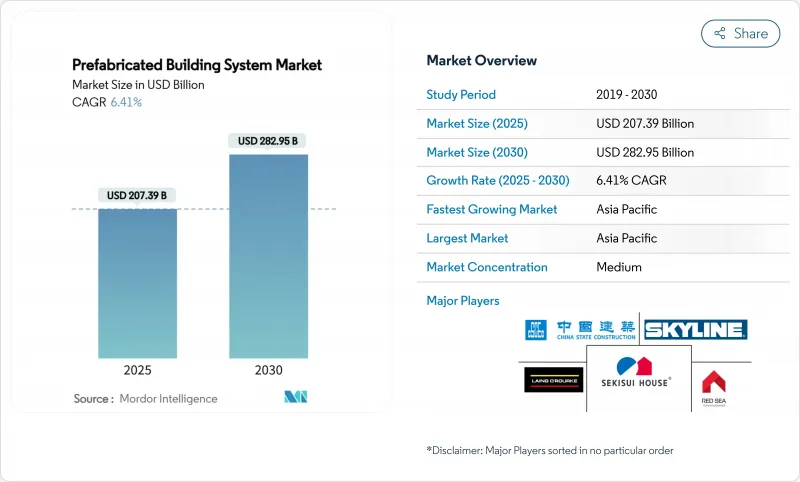
|
市場調査レポート
商品コード
1851301
プレハブ建築システム:市場シェア分析、産業動向、統計、成長予測(2025年~2030年)Prefabricated Building System - Market Share Analysis, Industry Trends & Statistics, Growth Forecasts (2025 - 2030) |
||||||
カスタマイズ可能
適宜更新あり
|
|||||||
| プレハブ建築システム:市場シェア分析、産業動向、統計、成長予測(2025年~2030年) |
|
出版日: 2025年07月16日
発行: Mordor Intelligence
ページ情報: 英文 120 Pages
納期: 2~3営業日
|
概要
プレハブ建築システム市場規模は2025年に2,073億9,000万米ドルと推定され、2030年には2,829億5,000万米ドルに達すると予測され、予測期間(2025-2030年)のCAGRは6.41%です。

現在の拡大は、労働力不足、政策的インセンティブ、建設現場規模で工場レベルの精度を実現する技術に支えられています。都市部での世帯形成の増加、住宅価格の値ごろ感の悪化、グリーンビルディング基準の義務化が、公共機関や民間デベロッパーを、現場での作業を50%以上削減するオフサイト製造ソリューションへと向かわせています。大手サプライヤーが設計、生産、組立を統合し、バリューチェーン全体でマージンを獲得するため、統合が激化しています。ロジスティクスの最適化、消防法の調和、継続的な材料革新は、プレハブ建築システム市場の成長の勢いを持続させるための決定的なレバーであり続ける。
世界のプレハブ建築システム市場の動向と洞察
加速する都市化と住宅不足
都市の中心部は膨張しており、ASEANの都市は2030年までに9,000万人の追加人口を吸収すると予想され、従来の建設能力を上回っています。2029年までに120万戸の新築住宅を供給するというオーストラリアの公約のような国家計画は、プロジェクト・サイクルを最大40%短縮する輸入モジュラー・コンポーネントに大きく依存しています。大規模な移行により、デベロッパーは標準化されたフロアプレートと、許認可の複雑さを軽減し、並行生産を可能にする反復可能なモジュールの採用を余儀なくされています。モジュール工場は24時間操業が可能で、毎月の住宅引渡しスケジュールに合わせた予測可能な生産量をもたらします。その結果、プレハブ建築システム市場は、ニッチな代替案から、高成長都市回廊の主要な住宅供給チャネルへと進化しつつあります。
政府のインセンティブとグリーンビルディング義務化
カナダの連邦住宅建設計画(Build Canada Homes)は、プレハブ工法を導入する建設業者に対して250億米ドル以上を確保し、オフサイト製造に対する明確な調達優遇措置を設けています。米国では、第45L条税額控除により、エネルギー効率の高い住宅に対して1戸当たり最高5,000米ドルが支給されます。米国エネルギー省のZero Energy Ready Homeガイドラインは、HVAC、断熱材、屋上ソーラーを統合したモジュール式集合住宅を優遇する性能基準をさらに強化しています。EU全体では、2025年に建築物のエネルギー性能に関する規制が改正され、ライフサイクル炭素計算が義務付けられ、工場で管理された生産が最も廃棄物の少ない供給モデルとして位置づけられています。こうした政策の収束により、プレハブ建築システム市場は複数年にわたる需要の見通しが保証されます。
高い物流コストとサイズの制約
容積式ユニットの移動には、広幅の積載許可証、護衛車両、慎重に順序を決めた配送窓口が必要であり、その結果、一戸建てモジュール1個当たりの輸送費が2万5,000米ドルに達する可能性があります。完成したモジュールには大量の空気が含まれているにもかかわらず、トラックの荷台全体を占めているため、コスト対重量比は依然として不利なままです。橋梁のクリアランス、旋回半径、車軸重量の制限により、モジュールの設置面積は小さくならざるを得ないことが多く、工場効率を低下させる現場での縫製作業が増えることになります。地域に分散したマイクロ工場に投資することで、距離的な不利を軽減することはできるが、資本集約度は高まる。こうした制約を克服できるかどうかで、プレハブ建築システム市場が低密度またはインフラ制約のある地域にどれだけ広く浸透できるかが決まる。
セグメント分析
2024年のプレハブ建築システム市場では、複合システムが35.04%のシェアを占め、CAGRは7.56%とトップでした。開発者は、迅速なエンクロージャーとともに構造的完全性を提供し、取引上の引き継ぎを減らし、クリティカルパスのスケジュールを短縮する、スケルトンとパネルの統合プラットフォームを好んでいます。このようなハイブリッド・アセンブリは、鉄骨やコンクリートフレームを現地で製造し、ファサードや内装パネルをグローバルに出荷できるため、国境を越えた調達が簡素化されます。
特に、ポディウムレベルのオープンスパンから、その上の反復的な住宅モジュールに移行する複合用途のタワーでは、需要が旺盛です。ビルディング・インフォメーション・モデリング(BIM)が普及するにつれ、設計者はスピード、コスト、建築表現のバランスを取るために、ボリュームコア、パネル化されたファサード、スチール製メガフレームの最適な組み合わせを指定するようになります。プレハブ建築システム市場は、バンドルされた製品によってワンストップ調達が可能になり、従来の下請け契約にありがちなインターフェイスのリスクが軽減されるというメリットを享受しています。
コンクリートは2024年のプレハブ建築システム市場シェアの49.56%を占め、成熟したサプライヤーネットワークと多様な荷重条件下での実証された耐久性から強みを引き出しています。配筋の自動化、3Dプリンターによる型枠、超高性能ミックスにより単価が下がり、パネルの薄型化が可能になり、コンクリートの設計自由度が拡大しています。しかし、この分野は、低クリンカーセメントや再生骨材を採用し、市場での地位を守ろうとする生産者に迫られています。
木材のCAGRは最速の7.34%を記録し、炭素クレジットを提供する管轄区域や、生物由来材料の迅速な許認可で、割高な評価を得ています。エンジニアードウッドパネル、ダウエルラミネートスラブ、木材とスチールのハイブリッドコネクターは、18階建ての認可を取得し、歴史的な制限を取り払いました。
プレハブ建築システムレポートは、寸法別(スケルトンシステム、パネルシステム、その他)、素材別(コンクリート、スチール、木材、その他)、工法別(2次元パネル工法、3次元容積工法、ハイブリッド工法)、用途別(住宅、非住宅)、地域別(北米、南米、欧州、アジア太平洋、中東アフリカ)に分類されています。市場予測は金額(米ドル)で提供されます。
地域別分析
アジア太平洋地域は2024年の売上高の48.91%を占め、中国の1兆米ドルの経済特区投資による大規模なモジュール工場展開とシンガポールの90%の高層プレハブ採用率に支えられました。地域政府は、産業政策と都市部の住宅建設目標を結びつけ、長期的な工場能力を確保する継続的なプロジェクトパイプラインを確保しています。アジア太平洋地域のプレハブ建築システム市場規模はCAGR 7.25%の勢いであるが、これは域内貿易と、国産技術の成熟を促進する国産材要件の高まりの両方を反映しています。
北米は、カナダにおける5,000万米ドルの地域住宅建設イノベーション・イニシアティブと、米国におけるモジュール式ユニットを恒久的な不動産に分類するゾーニング改革が後押ししています。さらに、工場で生産される密閉性の高い外皮を好む厳しい建築エネルギー基準によって、その勢いは維持されています。内陸の物流回廊が改善され、国境を越えた大量出荷のコスト負担が軽減されるにつれて、この地域のシェアは上昇に転じると予想されます。
欧州は、労働力不足、住宅ストックの老朽化、全ライフサイクルでの炭素情報開示を義務付けるグリーンディール指令などを背景に、着実な前進を続けています。特に北欧やオランダでは、先進的な自治体が公共入札にオフサイト建設基準を含めるようになっています。中堅の生産者は高速鉄道回廊の近くに集まっており、複数の首都にまたがる夜間配送を可能にしています。
その他の特典:
- エクセル形式の市場予測(ME)シート
- 3ヶ月間のアナリストサポート
よくあるご質問
目次
第1章 イントロダクション
- 調査の前提条件と市場の定義
- 調査範囲
第2章 調査手法
第3章 エグゼクティブサマリー
第4章 市場情勢
- 市場概要
- 市場促進要因
- 加速する都市化と住宅不足
- 政府奨励金とグリーンビルディング義務
- 建設業における労働力不足と賃金上昇
- 木材モジュールのカーボンクレジット収益化
- 気候変動に強い急速展開型住宅の需要
- 市場抑制要因
- 高い物流コスト/規模の制約
- 細分化されたモジュラービルの高層防火基準
- 従来の建築との統合
- バリューチェーン分析
- ポーターのファイブフォース
- 供給企業の交渉力
- 買い手の交渉力
- 新規参入業者の脅威
- 代替品の脅威
- 競合の程度
第5章 市場規模と成長予測
- ディメンション別
- スケルトン・システム
- パネルシステム
- セルラー/容積計システム
- コンバインド/ハイブリッドシステム
- 材料別
- コンクリート
- スチール
- 木材
- その他(アルミニウム、複合材料)
- 工法別
- 2次元パネル
- 3次元容積計
- ハイブリッド(2D+3D)
- 用途別
- 住宅
- 非住宅
- インフラストラクチャー
- 商業
- 産業/団体
- 地域別
- アジア太平洋地域
- 中国
- 日本
- インド
- 韓国
- ASEAN
- その他アジア太平洋地域
- 北米
- 米国
- カナダ
- メキシコ
- 欧州
- ドイツ
- 英国
- フランス
- イタリア
- スペイン
- ロシア
- 北欧
- その他欧州地域
- 南米
- ブラジル
- アルゼンチン
- その他南米
- 中東・アフリカ
- サウジアラビア
- アラブ首長国連邦
- エジプト
- 南アフリカ
- ナイジェリア
- その他の中東・アフリカ
- アジア太平洋地域
第6章 競合情勢
- 市場集中度
- 戦略的動向
- 市場シェア(%)/ランキング分析
- 企業プロファイル
- Abtech Inc.
- Algeco Scotsman
- Astron Buildings
- Butler Manufacturing
- CSCEC Modular(China State Construction)
- Kirby Building Systems
- Laing O'Rourke
- Lindal Cedar Homes
- MMY Global Ltd.
- Modular Engineering
- Niko Prefab Building Systems
- Par-Kut International
- Red-Sea International
- Schulte Building Systems
- Sekisui House
- Skyline Homes
- United Partition Systems,Inc
- Vardhman Pre-Engineered Building Systems
- Vederra Modular

